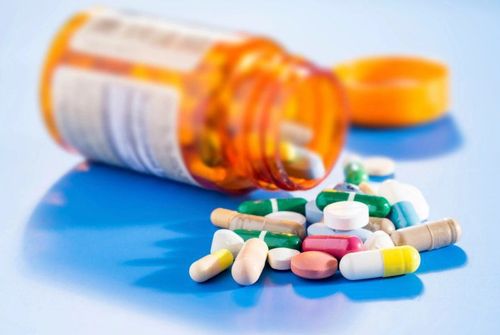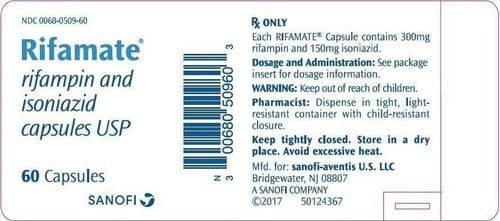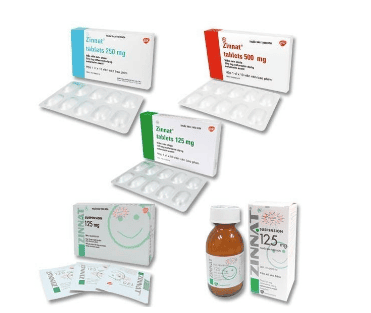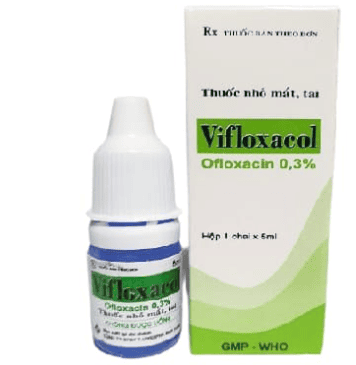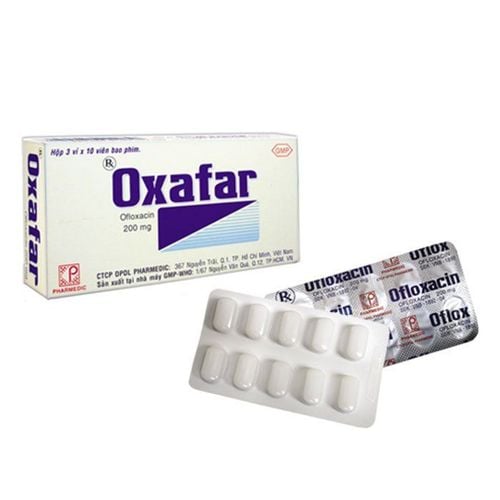This is an automatically translated article.
The drug Floxadrop contains the active ingredient Ofloxacin and other excipients in a sufficient amount. This drug is available in two dosage forms: 200mg tablets and 3mg/ml eye drops. This is an antibiotic that is used to treat bacterial infections.
1. What is Floxadrop?
The drug Floxadrop contains the active ingredient Ofloxacin and other excipients in a sufficient amount. This drug is available in two dosage forms: 200mg tablets and 3mg/ml eye drops. This is a fluoroquinolone antibiotic used in the treatment of bacterial infections.
1.1. Pharmacodynamics of active ingredient Ofloxacin Active ingredient Ofloxacin is an antibacterial drug of the Fluoroquinolone group, with a broad spectrum of antibacterial activity. The mechanism of action has not been fully studied. Similar to other antibacterial Quinolone antibiotics, Ofloxacin inhibits DNA-gyrase, an enzyme necessary for the replication, transcription and translation of bacterial DNA. germicidal. Ofloxacin is thought to inhibit bacterial DNA synthesis specifically through inhibition of DNA gyrase (topoisomerase II) and topoisomerase IV activities.
1.2. Pharmacokinetics of the active ingredient Ofloxacin Absorption: Active ingredient Ofloxacin is rapidly and well absorbed from the gastrointestinal tract. The drug is widely distributed into body fluids, including cerebrospinal fluid, and penetrates well into tissues. The drug crosses the placenta and is excreted in milk and has relatively high concentrations in bile. Metabolism: At single dose, less than 10% of Ofloxacin is metabolized to Desmethyl- ofloxacin and Ofloxacin N- oxide. Ofloxacin is filtered by the glomerulus and excreted by the renal tubules. Elimination: 75-80% of the active substance Ofloxacin is excreted in the urine as unchanged drug in 24 to 48 hours, resulting in high concentrations in the urine. The remainder of the drug is excreted as metabolites in the urine and excreted in the feces. Only small amounts of ofloxacin are eliminated by hemodialysis.
2. What is Floxadrop used to treat?
Floxadrop tablets are used in the treatment of the following pathologies:
Treatment of complicated and uncomplicated urinary tract infections. Treatment of skin and soft tissue infections. Treatment of prostatitis. Treatment of sexually transmitted diseases such as: uncomplicated acute gonococcal infection of the urethra and cervix, and non-gonococcal urethritis and cervicitis. Treatment of pneumonia caused by H. influenza or Streptococcus pneumoniae. Treatment of chronic bronchitis in acute exacerbations. Floxadrop ophthalmic solution is used in the treatment of the following pathologies:
Treatment of infections of the outer eye caused by strains susceptible to Ofloxacin: Treatment of conjunctivitis, corneal ulcers, lacrimal sac inflammation. Treatment of eyelid inflammation, eyelid cartilage inflammation, stye (crack, stye)
3. Usage and dosage of the drug Floxadrop
3.1. Dosage in tablet form For adults:
Dosage for cystitis caused by E. coli or K. pneumoniae: 200mg every 12 hours for 3 days. Dosage for treatment of cystitis caused by other bacterial infections: 200 mg every 12 hours for 7 days. Dosage for the treatment of complicated urinary tract infections: 200mg every 12 hours for 10 days. Dosage for moderate or mild skin and soft tissue infections: 400mg every 12 hours for 10 days. Dosage for acute exacerbation of chronic bronchitis or pneumonia: 400 mg every 12 hours for 10 days. Sexually transmitted diseases:
Dosage for treatment of uncomplicated gonococcal infections: 400mg as a single dose. Dosage for treatment of urethritis or cervicitis caused by C. trachomatis: 300mg every 12 hours for 7 days. Dosage for prostatitis: 300mg every 12 hours for 6 days. Dosage in patients with impaired renal function: Creatinine clearance > 50ml/min: use the usual adult dose, every 12 hours. Creatinine clearance 10 - 50 ml/min: Use the usual therapeutic dose in adults, every 24 hours. Creatinine clearance < 10ml/min: use 1⁄2 of the usual therapeutic dose in adults, every 24 hours 3.2. How to use the drug with eye drops Dosage depends on the health condition and level of infection of each person, which is decided by an eye specialist. Apply 1 drop in each eye, every 2 to 4 hours, so for 2 days. Then, check 4 times a day, 1 drop each time, for another 5 days. Currently, the safety and effectiveness of Floxadrop have not been established in children under 1 year of age.
3.3. In case of overdose of Floxadrop: Symptoms of an overdose of Floxadrop may be experienced such as drowsiness, nausea, dizziness, heat and cold, flushing, swelling of the face and disorientation during the day. space from light to moderate. In case you suspect someone has overdosed on Floxadrop, you need to immediately take the overdose to medical facilities for proper treatment. The treating doctor will prescribe basic measures to remove the unabsorbed part of Floxadrop such as vomiting, gastric lavage, clinical monitoring and appropriate rehydration measures. At the same time, treating doctors also prescribe treatment of signs and symptoms and supportive treatment. In case of missed dose: You need to take the initiative to take the missed dose of Floxadrop as soon as you remember it. However, if the interval between the next dose is too short, you should skip the missed dose and continue taking it as before. You should note that, absolutely do not use twice the prescribed dose to make up for the previously forgotten dose.
4. Undesirable effects of the drug Floxadrop
During the use of Floxadrop tablets, patients may experience the following side effects:
Nervousness: headache, dizziness, fatigue, tremor, insomnia, frequent nightmares, confusion visual disturbances. Gastrointestinal: nausea, vomiting, diarrhea, abdominal pain, digestive disorders. Skin: rash, pruritus, vasculitis, photosensitivity skin reactions, cutaneous hypersensitivity-type skin reactions. Renal: acute renal failure secondary to interstitial nephritis. Adverse effects with other organs: blurred vision, increased number of eosinophils, decreased number of neutrophils, decreased platelet count, muscle fatigue, gynecomastia. When using Floxadrop eye drops, patients may experience the following side effects:
May cause temporary irritation or hypersensitivity reactions. May cause cross-allergic reactions. When you encounter unwanted effects on your health, the thing to do is to stop using the drug. With mild adverse reactions, it is usually sufficient to discontinue the drug. In case of severe hypersensitivity or allergic reaction, it is necessary to carry out supportive treatment such as ensuring a well-ventilated room and using Epinephrine, breathing oxygen, using antihistamines, corticosteroids....
You need to proactively notify Talk to your doctor or other health care professional if you experience other serious side effects while using Floxadrop.
5. Floxadrop drug interactions
Interactions of Floxadrop drugs may occur during use as follows:
Concurrent use of drugs containing Ofloxacin active ingredient with non-steroidal anti-inflammatory drugs (Aspirin, Diclofenac, Dipyrone, Indomethacin, Paracetamol), effects cause psychosis does not increase. No special caution is required when using Floxadrop with Quinolone antibiotics, non-steroidal anti-inflammatory drugs. The absorption of the active ingredient Ofloxacin is not altered by the antibiotic Amoxicillin. Serum concentrations of ofloxacin may fall below therapeutic levels when Floxadrop is used concomitantly with aluminum and magnesium antacids. To avoid Floxadrop drug interactions, patients need to inform their doctors about the drugs, herbs, and health care products they are using so that the doctor can consider and prescribe them appropriately.
6. Some notes when using the drug Floxadrop
During the use of Floxadrop, patients should pay attention to the following issues:
6.1. Contraindications of the drug Floxadrop People who are sensitive or hypersensitive to the main active ingredient is Ofloxacin and other Quinolones. Children under the age of 15 years. 6.2. Floxadrop should be used with caution in patients with epilepsy or a history of central nervous system disorders. Dosage should be reduced in patients with renal impairment. Effects of Floxadrop on Drivers and Machine Operators: There have been reports of drowsiness, loss of concentration, dizziness and visual disturbances when using drugs containing the active ingredient Ofloxacin. Therefore, drug users should avoid driving or operating machinery while taking the drug. When the drug Floxadrop is used together with alcohol, these symptoms can be increased. 6.5. How to store Floxadrop To ensure quality, Floxadrop should be stored as follows:
Store Floxadrop in a cool, dry place, not in a humid place, avoid placing it in direct sunlight. medicine. Do not leave Floxadrop medicine in a place with too low or too high temperature, the average temperature to store the medicine is about 25 degrees Celsius. Keep Floxadrop out of reach of small children and pets in your family. . Above is all information about the drug Floxadrop, patients need to carefully read the instructions for use, consult a doctor / pharmacist before use. Absolutely do not arbitrarily buy Floxadrop medicine to treat diseases at home, because there may be unwanted side effects on health.
Follow Vinmec International General Hospital website to get more health, nutrition and beauty information to protect the health of yourself and your loved ones in your family.





